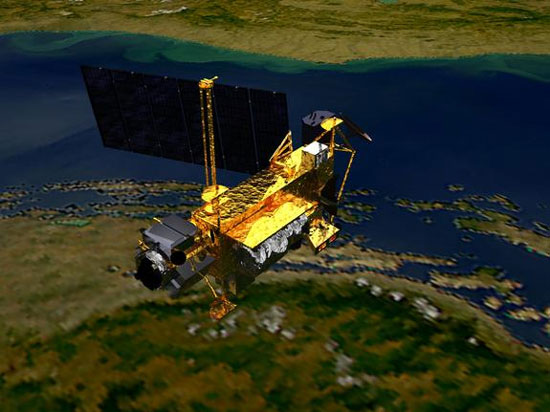The US satellite has plunged into the Pacific Ocean
The US Aeronautics Agency (NASA) this afternoon confirmed that their failed satellite had fallen toward the Pacific Ocean, but scientists had not determined the exact location.
>>>Vietnam can catch satellite fragments
>>> NASA satellite videos are falling in the universe
NASA announced that the Research Satellite at the Upper Floor (UARS) falls around 5am GMT this morning and rushes towards the Pacific Ocean.
"Center for Space Operations commanders at California state Vandenberg Air Force Base announces that UARS satellite rushes through the atmosphere above the Pacific Ocean. Time for satellite to fall and its debris dive down has not yet been correctly determined, " BBC quoted NASA as a statement.
Some news on social networking site Twitter said that many UARS fragments fell west of Canada. But Canadian officials and NASA have not confirmed this information.
NASA officials believe that most of the 6-ton satellites will ignite in the process of rubbing with air, but the computer model shows about 26 pieces - with a total mass of up to 500kg - will not burn. over. They will plunge into an area of 400 to 500km width. Because the oceans cover 70% of the Earth's surface, the chances of them falling into the water are anticipated.

Space Shuttle Discovery takes the Floor Research satellite
The upper body went out on September 14, 1991. (Photo: NASA)
"Remember that the debris is small despite the satellite being as big as the bus. If they fall into the ocean, that means we can hardly find them," said Stephen Cole, NASA spokesman. , to speak.
Within half a month, NASA continuously corrected the fall time and location of UARS. Initially they reported that the artificial satellite would fall in late September or early October. On September 17, NASA announced that the UARS would fall to any place in the area between 57 North latitudes and 57 South latitudes. of the equator on September 24, Vietnam is located in this area.
By September 22, NASA said the satellite would fall on September 23, earlier than their calculations due to satellite acceleration during the fall. The reason is that the amount of ultraviolet rays from the sun increases. As the amount of ultraviolet rays increases, the earth's atmosphere will expand, causing the earth's gravitational pull to increase. So UARS falls faster. But that prediction did not come true on September 23. NASA finally thought that UARS fell into the morning and debris could plunge into Canada and Africa.
Predicting the time and place of the fall of cosmic trash is difficult because many factors affect their fall - such as the expansion of the atmosphere, the shape of the garbage, the direction of falling, atmospheric pressure. , the wind. NASA once claimed they could pinpoint UARS's fall site about two hours before it entered the atmosphere, but they had not done it.
The New York Times said UARS's true death has become a hot topic for both the media and the online community in recent days. Almost every major news agency predicts the time and location where UARS fragments will fall. On the Facebook page, people link stories together and give their thoughts, like 'Maybe I should wear a hard hat' or 'Should we care about this fall?'.
On MSNBC.com , about 5,000 readers made their predictions in a survey of UARS. 10% of readers were relieved that it did not plunge into North America, 34% felt sorry that 'there is no chance to watch the fireworks in the sky due to the fragments of satellites flaming down' However, up to 44% of respondents were worried about areas outside North America.
Nicholas L. Johnson, a NASA space garbage expert, said the possibility of debris falling on any person in the world is one-trillion.
Rabbi Carroll, a netizen in the US, said that NASA's tightness in the satellite fall is a good measure in disaster management.'I think NASA knows exactly where and when the satellite will fall. But if they publish the information, thousands of idiots will rush to where the satellite falls and wait for a piece to fall. Then their lawyers can sue NASA, " Carroll commented.
- What happens when a meteorite is
- Why don't planes often fly across the Pacific Ocean?
- Video: Strange object 4 km in diameter at the bottom of the Pacific Ocean
- NASA satellite crashed into the Pacific Ocean and went missing
- 3 Glonass satellites of Russia fall into the Pacific Ocean
- Korea will launch satellites from the Pacific Ocean
- Russian military satellites fall into the Pacific Ocean
- Discovered a huge gold store at the bottom of the Pacific Ocean
- Video: The mysterious dark shadow is as big as a country on the Pacific Ocean
- Twin-minded storms on the Pacific Ocean from the universe
- Russian satellites are about to fall to Earth
- French athletes swim 8,850km across the Pacific
 Van Allen's belt and evidence that the Apollo 11 mission to the Moon was myth
Van Allen's belt and evidence that the Apollo 11 mission to the Moon was myth The levels of civilization in the universe (Kardashev scale)
The levels of civilization in the universe (Kardashev scale) Today Mars, the sun and the Earth are aligned
Today Mars, the sun and the Earth are aligned The Amazon owner announced a secret plan to build a space base for thousands of people
The Amazon owner announced a secret plan to build a space base for thousands of people